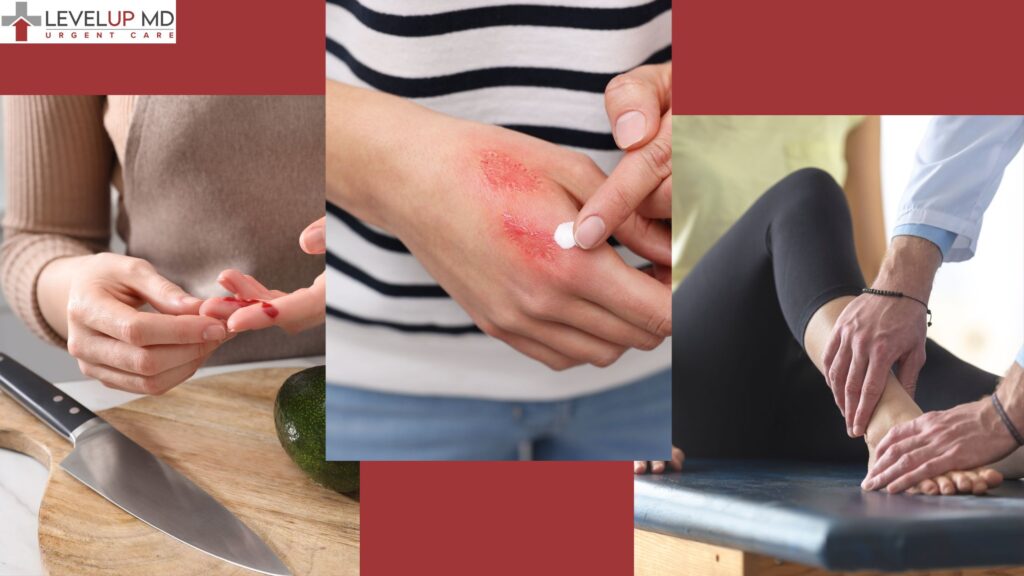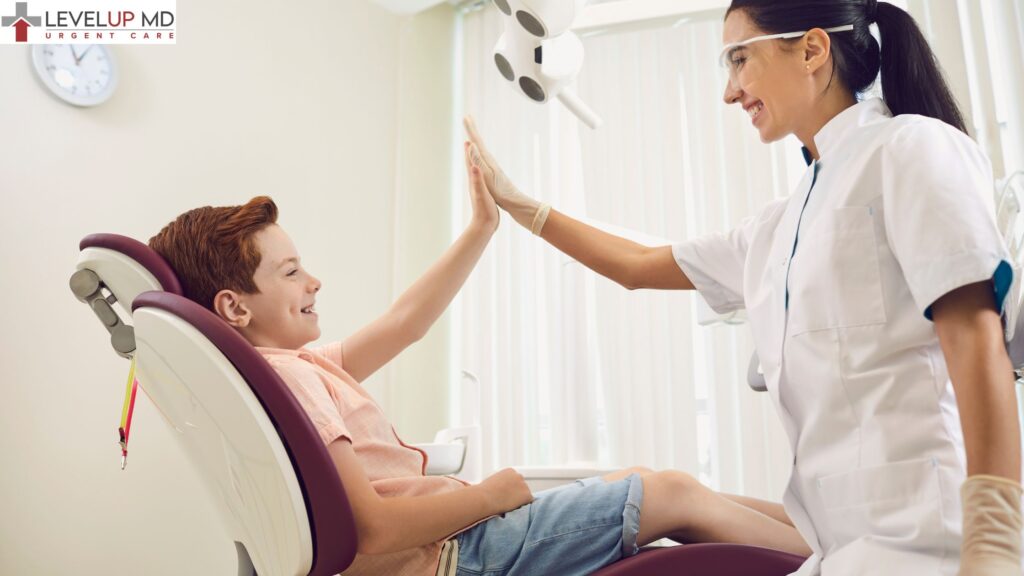
Why Visit an Urgent Care Center?
6 Common Reasons Explained
Urgent care centres provide a convenient and efficient solution for treating non-life-threatening conditions that require immediate medical attention. Whether you’re dealing with minor injuries, burns, or sports-related incidents, visiting a walk-in urgent care clinic can save you time and provide high-quality care without needing an emergency room visit. If you’ve been searching for “urgent care near me,” it’s essential to understand the types of injuries and treatments available at these facilities.
1. Minor Injuries Treated at Walk-In Clinics

Minor Injuries are the most common reason to visit Urgent care centers because they are well-equipped to handle injuries, offering quick assessments and treatment. The convenience of working hours and short wait times make them ideal for busy individuals and families seeking prompt medical attention. Below are some of the most common injuries treated at centers.
Sprains and Strains
A sprain or strain can happen unexpectedly during your workout, daily activities, or work. Immediate care providers assess these injuries using physical examinations and, if necessary, imaging tests such as X-rays to rule out fractures. Once diagnosed, treatment typically includes pain relief measures, supportive bracing, and mobility recommendations to prevent further injury.
RICE (Rest, Ice, Compression, Elevation): What to Do Before Visiting
If you suspect a sprain, applying the RICE method – Rest, Ice, Compression, and Elevation-can help minimize swelling and discomfort before visiting nearby urgent care centers.
When to Consider Physical Therapy After a Sprain
If pain persists or mobility is significantly impacted, physical therapy can enhance strength and flexibility, ensuring a full recovery and preventing long-term complications.
Cuts and Lacerations
Deep cuts or lacerations often require stitches to promote proper healing and prevent infection. A professional doctor can determine whether stitches, adhesive strips, or medical glue are necessary. If a wound is deep, bleeding heavily, or exposes underlying tissue, seeking immediate care is crucial.
Preventing Infection for Minor Cuts
To avoid any infection a Proper wound care is essential. Before heading to a nearest walk-in clinic, cleanse the wound with mild soap and water, apply antiseptic ointment, and cover it with a clean bandage.
Caring for Wounds at Home After Treatment
Keeping the wound clean, changing bandages regularly, and watching for signs of infection, such as redness, swelling, or pus discharge are the some caring you need to execute at home.
How to Identify Signs of Infection That Require Medical Attention
Signs of infection include increased pain, warmth around the wound, fever, and red streaks spreading from the site. If any of these symptoms appear, visit an immediate clinic near your locality for further evaluation.
Burns Treated at Clinics (First- and Second-Degree)
A walk-In Clinic commonly treats first- and second-degree burns, which affect the outer and underlying skin layers. First-degree burns, such as mild sunburns, cause redness and minor discomfort, while second-degree burns result in blistering and increased pain. Severe burns, however, may require emergency medical attention.
Immediate Steps to Take for Burn Injuries
Before heading to the clinic, it’s crucial to cool the burn under running water, avoid breaking blisters, and cover the affected area with a clean cloth. Applying ice directly should be avoided, as it can worsen tissue damage.
When to Seek Emergency Care Instead of Walk-In Clinic
Minor to moderate burns can be managed at a clinic, but deep burns, electrical burns, or those covering a large body area should be treated at an emergency room instead.
Common Sports Injuries Treated
It is also one of the most common reasons to visit Urgent Care Centers frequently. Playing sports increases the risk of sprains, fractures, and muscle strains. There is a high chance as an enthusiastic sports player you receive a sprain while playing. A nearby clinic provides X-rays, splints, and pain management solutions to facilitate recovery.
When to Return to Physical Activity After an Injury
Returning to physical activity too soon can lead to further damage. A doctor can help you to determine the appropriate time to resume sports by assessing your condition. A gradual return plan is usually advised to prevent setbacks. You are also advised to use proper protective gear, such as knee braces, ankle supports, and helmets, to prevent future injuries.
2. Illnesses Treated
Whether it’s a nasty flu, a stomach bug, or an unexpected rash, you can walk right in and get the care you need without the hassle. Let’s break down some common reasons to visit Urgent Care Centers for illnesses that can be handled and what you should know before heading in.
Flu, Cold, Annual Physical, COVID-19 Positive Care, and Respiratory Infections

So, you’re feeling pretty rough—fever, cough, body aches? It might be the flu or even COVID-19. The good news? Walk-in clinics offer rapid testing to determine what’s going on immediately. Getting tested quickly means starting treatment sooner and, most importantly, avoiding spreading it to others.
Managing Symptoms for Fast Recovery
Once diagnosed, a personalized treatment plan—including medications, hydration therapy, and symptom management tips—will help you recover faster.
Flu Shots and Preventive Care Available
Preventive services like flu shots and other vaccinations are available to protect against seasonal illnesses. If you’ve been putting it off, stopping by for a quick shot can help avoid future sickness.
How Urgent Care Helps Manage Seasonal Allergies
If you struggle with allergies, you know how annoying they can be. Whether it’s sneezing, itchy eyes, or constant congestion, seasonal allergies can take a toll. The good thing is that urgent care can help with allergy testing, medications like antihistamines or inhalers, and advice on minimizing exposure during peak allergy seasons.
Stomach Bugs, Abdominal Pain, and Food Poisoning

We’ve all been there—something you ate didn’t sit right, or a stomach virus is making the rounds. If you’re dealing with persistent vomiting, diarrhea, or signs of dehydration, don’t wait it out too long.
When to Take a Child to Walk-In Clinics for Stomach Issues
It’s tough when your child is sick, and knowing when to seek medical help can be stressful. If they have ongoing vomiting, severe stomach pain, a high fever, or signs of dehydration like dry mouth and reduced urination, it’s time to visit a pediatric urgent care expert. The pediatric doctors are trained to handle little ones with care and get them feeling better fast.
Diagnosing and Treating Allergic Reactions Quickly
Got a rash or sudden itching? Allergic reactions can hit out of nowhere; it’s best to act fast when they do. A doctor can assess your symptoms, provide relief with medications, and ensure it’s nothing more serious.
Topical Treatments and Medications Available
For those annoying rashes that won’t go away, immediate care centers providers can prescribe creams, antihistamines, and soothing lotions to calm things down. You’ll leave with the proper treatment and peace of mind, whether eczema, contact dermatitis, or a mystery rash.
Skin Conditions That Need Medical Attention
Not every rash is minor. If your skin is blistering, infected, or getting worse, urgent care can help determine if further treatment is needed. They can handle conditions like minor infections, eczema flare-ups, and allergic reactions that aren’t improving with over-the-counter products.
3. Workplace Injury

Workplace injuries are also a common reason to visit urgent care centers. Knowing where to go can make all the difference, whether it’s a minor cut or something more serious like a repetitive strain injury at the workplace. With convenient working hours, you can walk in any time without an appointment and get back on track with minimal disruption.
Common Workplace Injuries
Let’s face it—workplace injuries can happen in any job, whether you’re working in an office or on a construction site. The good news is that you can be treated and back to work as soon as possible.
Examples of Injuries from Slips, Trips, and Falls
Slips, trips, and falls are the most frequent workplace injuries. Whether you’ve slipped on a wet floor or tripped over equipment, these accidents can lead to sprains, fractures, and head injuries.
Recognizing Repetitive Strain Injuries (RSIs)
If your job involves repetitive movements—like typing, lifting, or assembly line work—you might develop an RSI (Repetitive Strain Injury) over time. Conditions like carpal tunnel syndrome, tendonitis, and muscle strain can sneak up on you and become chronic if left untreated. A doctor can evaluate your symptoms and provide treatment, such as physical therapy referrals, splints, and pain management strategies to keep you going strong at work.
Handling Minor Cuts and Bruises on the Job
Not every workplace injury is an emergency, but even minor cuts and bruises should be taken seriously. Immediate Clinics can clean and treat minor wounds to prevent infection and ensure proper healing.
When to Seek Immediate Medical Care for Workplace Injuries
If you’re dealing with severe pain, heavy bleeding, or possible fractures, don’t wait—head to a nearby care center right away. Quick medical attention can prevent further complications and help you return to work safely and efficiently.
Avoiding Complications from Untreated Injuries
Ignoring a minor injury can turn it into a significant problem. Whether it’s a sprain that isn’t healing properly or a small cut that gets infected, timely treatment can save you from more substantial health issues.
Occupational Health Services
Many centers offer specialized occupational health services, such as pre-employment physicals, drug testing, and injury prevention programs. If your job requires regular health checks or physical assessments, a clinic is convenient for getting them done.
Workers’ Compensation and Insurance Support
If you’re injured on the job, dealing with workers’ compensation can be overwhelming—but urgent care centers can help simplify the process. They’re experienced in handling work-related injury claims and can provide the medical documentation you need to get the support you’re entitled to.
4. STD Testing and Treatment

Your sexual health matters, and staying informed through regular testing is one of the best ways to take care of yourself. Getting tested doesn’t have to be complicated whether you’re experiencing symptoms or want peace of mind. Fortunately, many clinics offer discreet, affordable, and fast testing, making getting the answers you need easier than ever without unnecessary stress. Let’s dive into what you can expect from the screening and treatment process.
Common STDs Tests
If you’re wondering what sexually transmitted infections (STIs) can be diagnosed during a routine visit, the answer is—quite a few. Testing covers many infections, allowing for early detection and treatment before complications arise.
What STDs Can Be Diagnosed
Common infections that can be identified through screening include chlamydia, gonorrhea, syphilis, HIV, herpes, and HPV. Some tests involve a simple urine sample or swab, while others may require a blood test.
Confidential and Same-Day Testing Options
Privacy is a top priority for most people considering a test. Many facilities offer confidential, same-day services—meaning you can walk in, get tested, and receive results discreetly. Whether dealing with symptoms or simply keeping up with regular screenings, the process is designed to be fast and stress-free.
Symptoms That Require Immediate Testing
If you’re experiencing burning during urination, unusual discharge, genital sores, or itching, it’s a good idea to get tested right away.
Regular Screening Recommendations for Sexually Active Individuals
Even if you feel completely healthy, regular screenings are recommended if you’re sexually active. Experts suggest annual testing for most individuals, but more frequent check-ups might be needed if you have multiple partners, engage in unprotected sex, or have a previous history of STIs.
Treatment Options for STDs
If a test returns positive, don’t panic—most infections are easily treatable with the right approach. Knowing what options are available and taking quick action can make all the difference in recovery and preventing further spread.
Medications Available for Common Infections
Depending on the diagnosis, treatment may include antibiotics for bacterial infections like chlamydia and gonorrhea or antiviral medications for conditions such as herpes and HIV.
Preventing Reinfection and Safe Practices
Once treatment is complete, practicing safe sex is crucial to avoid reinfection. Using protection, such as condoms or dental dams, and having open conversations with partners about sexual health can significantly lower the risk of future infections. Routine screenings should also become a regular part of your healthcare routine.
What to Expect During an STD Screening Visit
You might feel nervous if it’s your first time getting tested, but the process is usually quick and straightforward. A healthcare provider will ask about your sexual history, discuss any symptoms you may have, and recommend the appropriate tests. Results can often be accessed online or through a private phone call within a few days.
5. Pediatric Care Services

Caring for your child’s health can feel overwhelming at times, but having access to convenient, specialized pediatric services can make it easier. Let’s explore some of the most common conditions treated, how to handle minor injuries, and what you can do to make visits more manageable for you and your little one.
Common Childhood Illnesses Treated
Kids get sick—it’s just part of growing up. From fevers to ear infections, knowing when home remedies will do the trick or when to seek professional care can be challenging.
Fever, Cough, and Ear Infections in Children
Fevers and persistent coughs are the most common reasons parents seek medical attention for their children. While mild fevers can often be managed at home with fluids and rest, higher temperatures or prolonged symptoms might require further evaluation to rule out infections like strep throat or the flu. Ear infections, in particular, can cause significant discomfort and, if left untreated, may lead to complications.
When to Take Your Child to an Urgent Clinic vs. the ER
Knowing the difference between a situation that needs immediate emergency attention versus one that can be treated at a clinic. For example, a fever that doesn’t respond to medication, severe dehydration, or difficulty breathing are signs that a trip to the ER may be necessary. On the other hand, routine illnesses like colds, mild fevers, and minor infections can often be handled more efficiently at walk-in healthcare centers.
Vaccination Services and Wellness Checks
Staying on top of immunizations is one of the best ways to keep your child healthy. Many healthcare facilities offer routine vaccinations, protecting your child against preventable diseases such as measles, whooping cough, and the flu. Regular wellness checks also provide an opportunity to monitor growth and development, address concerns, and discuss preventive care strategies.
Pediatric Injury Care
Kids are naturally active and curious, which unfortunately means bumps, bruises, and the occasional more serious injury. Knowing how to handle these situations can help prevent minor incidents from becoming primary concerns.
Pediatric First Aid Tips for Parents
Being prepared for minor injuries at home can make all the difference. Parents should keep a well-stocked first aid kit with essentials such as bandages, antiseptic wipes, fever reducers, and an emergency contact list. Knowing basic first aid skills—like properly cleaning a wound or managing a sprain—can help prevent unnecessary trips to a clinic.
Tips for Parents Visiting Pediatric Healthcare Centers
Taking your child to a medical facility can be stressful, especially if they’re feeling unwell or anxious. Preparing can help make the experience smoother for everyone involved.
How to Prepare Your Child for a Medical Visit
Children often feel nervous about seeing a doctor, especially if it’s their first time or if they’ve had a negative experience. Talking to them calmly and reassuringly, explaining what to expect, and bringing a favorite toy or comfort item can make a big difference. Letting them know the visit will help them feel better and can ease their fears.
6. Preventive Care Services You Can Rely On
Staying on top of your health isn’t just about treating illnesses—it’s about preventing them in the first place. Regular check-ups, screenings, and vaccinations can help catch potential issues early and keep you feeling your best year-round. The great thing is that you don’t always need to schedule an appointment weeks in advance; you can walk in and get the care you need when it fits into your busy schedule.
Health Screenings and Wellness Checks
Life gets busy, and it’s easy to put off routine health checks. However, prioritizing preventive care can significantly improve your overall well-being. Whether it’s an annual physical or a routine screening, staying proactive about your health is one of the best decisions you can make.
Annual Physical Exams Available Without an Appointment
Need a physical but don’t have time to book an appointment? No problem. Walk-in exams are a quick and easy way to stay on top of your health without disrupting your schedule. Whether for work, school, or personal wellness, a comprehensive physical can give you valuable insights into your health and catch potential issues before they become more significant problems.
Screenings for Chronic Conditions (Diabetes, High Blood Pressure)
If you’re managing a chronic condition—or worried you might be at risk—routine screenings are essential. With quick screenings available, staying informed and in control of your health is easier than ever.
Supporting an Active Lifestyle
Regular health assessments can help you track your progress, identify potential concerns, and get professional advice on improving performance safely. Staying active is a great way to support overall wellness, and you can do it confidently with the proper guidance.
Travel Vaccinations and Immunizations

Planning a trip? Whether traveling for business or leisure, ensuring you’re protected against potential health risks is crucial. Different destinations come with varying health challenges, and being prepared can make all the difference in providing a safe and enjoyable trip.
What Vaccines You Need Before Traveling Abroad
Before heading to a new country, knowing what vaccinations are recommended—or even required—for your destination is essential. Certain areas may have a higher risk for hepatitis, typhoid, or yellow fever. A healthcare provider can help you understand which vaccines you’ll need based on where you’re going and how long you’ll be staying.
Walk-In Vaccination Services for Busy Individuals
Finding time for a vaccination appointment can be challenging between work, family, and travel planning. Luckily, walk-in services make it easier than ever to get vaccinated without rearranging your schedule. Whether you need a routine booster shot or specific travel-related immunizations, you can take care of it quickly and efficiently.
Flu Shots and Routine Immunizations for Families
Keeping the whole family protected is a priority, especially during flu season. Flu shots and routine immunizations like tetanus and measles boosters are available for individuals of all ages. Whether it’s for you, your kids, or elderly family members, getting vaccinated is a simple way to ensure everyone stays healthy year-round.
Health Precautions Before Business or Leisure Travel
Consulting with a medical professional before your trip can give you peace of mind and ensure you’re well-prepared for any health challenges.
Convenience of Choosing Walk-In Care Center
When you need medical care, convenience matters; whether you’re dealing with a minor illness or an injury or need a routine check-up, having access to a reliable healthcare provider close to home makes all the difference. A local walk-in clinics offer fast, efficient care with flexible hours to fit your busy schedule.
Why Choose Local Care Centers
Finding time to prioritize your health isn’t always easy, but choosing a local clinic can simplify the process. Whether you’re a working professional, a busy parent, or someone with an unpredictable schedule, local facilities provide the accessibility and flexibility you need to get care when it works for you.
Shorter Wait Times Compared to ER Visits
No one wants to spend hours in an emergency room for a non-life-threatening issue. Walk-in clinics are designed to provide care efficiently, with much shorter wait times than the ER. If you need treatment for minor injuries, flu symptoms, or routine medical needs, you can get in, get treated, and get back to your day—without the long wait.
How to Find the Nearest Center
Wondering where to go? Finding a nearby clinic is simple with online search tools and location maps provided by most healthcare providers. Many centers also offer real-time wait time updates and online check-in options so you can plan your visit and minimize waiting time.
Conclusion
From treating sprains and burns to offering flu shots and travel vaccinations, urgent care facilities are designed to meet your healthcare needs quickly and effectively—without the long wait times of an emergency room.

